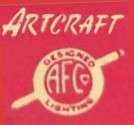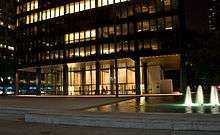Artcraft Fluorescent Lighting Corporation
 | |
| Private | |
| Industry | Lighting (#2 in the nation- Fluorescent Fixtures - approx. 1940-1954)[1] |
| Fate | Dissolved in 2002 (Original Corp. sold in 1968) |
| Founded | 1940 - 2002 (62 years) |
| Headquarters | Brooklyn, New York City, New York, United States |
Number of locations | New York, NY, Philadelphia, PA, Washington, DC |
Area served | United States (mostly east of the Mississippi) |
Key people | Louis Levy, President |
| Products | Fluorescent Fixtures, Neon Signs, Electric Fans |
| Revenue |
|
Number of employees |
|
Artcraft Fluorescent Lighting Corporation[4] was one of the top three manufacturers of fluorescent lighting fixtures in the United States from the time of the public introduction of the fluorescent lamp at the 1939 World's Fair. Artcraft announced a slimline ballast and showcase striplight fixture in 1946.[5][6]
Louis Levy started the business from money earned by assembling radios when he was about 20 years old. He was very intuitive.[7] Louis Levy and Max Wittenberg started the Artcraft Fluorescent Lighting Corporation about 1940.[2] Mr. Wittenberg managed the business, sales, and accounting office and Mr. Levy managed the manufacturing, fixture development, and production department. Fluorescent lighting was very new to consumers, businesses, and professionals, who were familiar with incandescent lighting.[8] The transition to this newer form of lighting was not easy.
The benefits of fluorescent lighting were lower operating costs, more light for the same power input, and less maintenance.[9] The idea took hold.[10] The company had over 200 employees at the factory and branch offices. Starting about 1959,[2] neon signs also were manufactured. The company began selling fixtures in the New York City area. They opened showroom offices in Manhattan, and then in Washington, DC and Philadelphia, PA about 1947, and began making and selling display cases and electric fans. Some customers opted for being on the installment plan, which was a growing trend then.[2] Sales and manufacturing skyrocketed by the mid-1950s east of the Mississippi, and many other companies were beginning to make fixtures. Max Wittenberg died in the late 1950s and Mr. Levy continued operations with a new partner until about 1968 when he sold the corporation. He was interested in going into the finance business.[7] The company remained in existence until about 2002 in Brooklyn, NY.[11]
[1948 Advertisements in Electrical Consultant magazine]
The corporation grew over time and was at its pinnacle in 1952. Artcraft received the prestigious "AAA" Dun & Bradstreet rating many times. Fewer than 10% of US corporations ever attain that status. While overseeing Accounts Payable, Accounts Receivable, Payroll, Profit & Loss Statements, banking correspondence, extension of credit to customers together with two full-time accountants and five to seven bookkeepers and support staff, among other duties, it was apparent the corporation was a profitable entity with Louis Levy and Max Wittenberg being the sole owners.[2] Company stock offerings were becoming popular, and issuance began with the employees yet not on the major exchanges.[7] Very few businesses had that credit rating for an extended duration, analogous to a 5A, ER3, 1 rating today.[2]
.jpg)

The three top companies from the beginning were, Lightolier, the largest, a division of Royal Philips Electronics, with approximately $500 million in annual sales, followed by Artcraft Fluorescent Lighting Corporation, and Globe Lighting Products, Inc., originating from New York City.[1][12]
Past officers included: Louis Levy—President, Max Wittenberg—Secretary and Treasurer, Jay Stern—Vice President, Bernard Luger—CFO, Chief Financial Officer, William B-Z. Fishkin—General Counsel.[13] Previous locations and operations were at Brooklyn, NY (original factory), New York, NY, Manhattan (showroom), Philadelphia, PA (showroom & sales office), and Washington, DC (showroom & sales office).[2]
References
Industrial Directory of New York State, 1949ed, 1953ed, 3468, pp. 638, 684
Lighting - Interior Lighting- Artemide (Firm), 63-64, 1953, p. 82
Lighting - Interior Lighting- Artemide (Firm), 53-54, 1948, pp. 175, 392
Mark Stanley Rea, ed. (c. 1993), Rensselaer Polytechnic Institute, Illuminating Engineering Society of North America, New York, Part IV Lighting Applications, Lighting Handbook Reference & Application (8th ed.), pp. 517–749, ISBN 0-87995-102-8 (previous editions published under title: IES lighting handbook)
Electrical Consultant (original from Cornell University - digitized, Feb 1, 2011 - Print Advertisement) Lighting & Lamps, 53, 1948, p. 21
Electrical West (original from McGraw-Hill Company of California., 1967), 134, 1967
Chain Store Age - Super Markets, 40, 1964, p. 64
"United States Library of Congress", Dun & Bradstreet Corporation Records (Science, Technology & Business Division) John Adams Building Collection, located off-site at Fort Meade, 1945, 1948, 1952, 1953, 1954, 1955, Washington, DC, pp. 1481 (Manhattan and Bronx, September 1945), September 2016
Arthur A. Bright & Rupert Maclaurin (1943), Economic Factors Influencing The Development and Introduction of The Fluorescent Lamp, The Journal of Political Economy, Massachusetts Institute of Technology, [MIT], University of Chicago Press, 51 (No.5), pp. 429–450
Arthur A. Bright, Jr. (1949), The electric-lamp industry: technological change and economic development from 1800 to 1947, New York, Macmillan Co., pp. 399–417, ISBN 0-405-04690-1
Moody's Dividend Record - Moody's Investors Service, Incorporated, 1948, Artcraft Fluorescent Corp., 7% partie, pfd, 1948, p. 143
Luger, Bernard (May 1995), "Documenting a corporation", Sillman Family Private Collection [Past United States Health Education and Welfare, Regional Inspector General for Audit (1966-1985), Region 3 and U.S. Joint Conference Intergovernmental Audits Forum, Chairman, New York/New Jersey region], 1: 2
Zaslowsky, Esq., Daniel (May 1995), "An era a long time ago", Sillman Family Private Collection, 2: 3
Levy, Paul (October 1998), "son of Louis Levy, Early industry leaders in New York City", Sillman Family Private Collection, 3: 4
Sillman, Suzanne (August 1996), "daughter of Louis Levy, An employee's perspective", Sillman Family Private Collection, 4: 5
Sillman, Richard (January 2011), "grandson of Louis Levy, A retrospective", Sillman Family Private Collection, 5: 6
Lighting the Way, Natural museum of American History, © 2015 Smithsonian Institution.
Lists
- 1 2 Paul Levy, Early industry leaders in New York City, Sillman Family Private Collection, 1998
- 1 2 3 4 5 6 7 Bernard Luger, CFO, Documenting a corporation, Sillman Family Private Collection, 1995
- ↑ Dun & Bradstreet Corporation Records 1945-1955, Library of Congress, Washington D.C., Retrieved September 2016
- ↑ Industrial Directory of New York State, 1949ed, 1953ed
- ↑ Electrical Consultant, Volume 50, Page 4, 1946 - Lighting, Volume 53 & 54, Page 174, 175, 1948
- ↑ Westinghouse Engineer, Volume 12-13, Page 141, 1952
- 1 2 3 Suzanne Sillman, An employee's perspective, Sillman Family Private Collection, 1996
- ↑ John H. Campbell, Lawrence Berkeley Laboratories, The University of California, Berkeley, California, The History and Technical Evolution of High Frequency Lighting, pages 1-2, 1977
- ↑ Mark Stanley Rea, PH.D. FIES, Editor-In-Chief, Rensselaer Polytechnic Institute, The Lighting Handbook and Reference, 1993
- ↑ Arthur A. Bright and Rupert Maclaurin, Economic Factors Influencing The Development and Introduction of The Fluorescent Lamp, The Journal of Political Economy, Massachusetts Institute of Technology, [MIT], University of Chicago Press, 51, No.5, 1943, pp. 429-450
- ↑ New York State, Division of Corporations, State Records
- ↑ Dan Blitzer, grandson of Lightolier founder, New York City, 2013
- ↑ Daniel Zaslowsky, Esq., An era a long time ago, Sillman Family Private Collection, 1995